Critical Reflections On Classroom Practice And The Key Principles Of Assessment for Learning To Guide Classroom Practice
| ✅ Paper Type: Free Essay | ✅ Subject: Teaching |
| ✅ Wordcount: 4354 words | ✅ Published: 23 Sep 2019 |
Critical Reflections On Classroom Practice And The Key Principles Of Assessment for Learning To Guide Classroom Practice
Introduction
“Assessment in education must, first and foremost, serve the purpose of supporting learning.” (Black & Wiliam, 2004)
Assessment is an essential part of any education as without assessment, the teacher does not know if their students are learning, if there are misconceptions that need addressing or what direction future lessons should take. There are two main forms of assessment – summative assessment (of learning) and formative assessment (for learning). Summative assessment encompasses activities such as the more formal end of unit testing, SATs, GCSEs etc. by which learning is checked although not necessarily acted on. Formative assessment is also referred to as Assessment for Learning (AfL) as its purpose is to drive the direction of learning and ensure that teaching and learning is effective. Creating an environment conducive to learning with the focus on the process as well as the performance is key to modern classroom practice; teachers continually assess the progress and understanding of their pupils while encouraging independent learning and growing autonomy. By constantly checking learning, teachers can adjust the pace and content of lesson in order to best meet the needs of all the learners. Compared to summative assessment, AfL is often much more informal and instinctive. However, it is an essential and integral part of every effective classroom using techniques such as questioning, listening in to children talking together, self-evaluation, peer assessment, discussions, observations and feedback. The productive marking of work during and between lessons is also an example of AfL; if the task is marked effectively and acted on swiftly by the pupil and, by influencing future lessons, teacher then it is formative assessment, driving teaching and learning. Even tests can be formative as well as summative if the teacher uses them to influence future lessons. For good teachers, AfL is an instinctive pattern of behaviours ensuring that they understand where their class is in its learning journey so that they can take the necessary steps to move them on towards their destination.
My exploration of aspects of AfL is based on reading and on a teaching placement in a mixed year 4/5 class with an above average number of children on the SEND register.
For this assignment I am focussing on two aspects of AfL: the impact of effective questioning on learning and; the importance of constructive feedback.
How Effective Use of Questioning can have a Significant Impact on Learning
For a long time, cognitivism, in particularly Piaget, was very influential within education, with the focus being on a child learning through actions and explorations according to their age, with language merely being a way of expressing the stage they were at,
“The role of language in Piaget’s thinking was secondary to action: thought derived from action, and language was simply the medium of expression of that understanding.” (Myhill, 2006, p21)
However, social constructivists, such as Vygotsky, believed that language is central to learning and that it is by verbalising our thoughts and ideas that we learn and develop new thoughts and ideas; when a person and discusses their ideas with others it helps to formulate and further develop that idea. Through verbal interactions with other people our understanding can be altered and clarified. (Myhill, 2006). For Piaget thought leads to language but Vygotsky proposed that language develops thoughts; over the past few decades this view of thinking has become more prevalent within education with teachers valuing the contribution of classroom talk to children’s cognitive as well as social development.
One central facet of classroom talk which, when used effectively, can really drive learning is the effective use of questioning. Questioning is important in the classroom because it not only checks learning but encourages children to become involved in critically analysing and exploring their own and each other’s ideas.
Though my time in schools, I have witnessed various types and situations where questioning was used effectively to assess and steer learning.
In a science lesson I observed (Appendix 1) the teacher used open and follow up questions effectively to not only assess what prior knowledge the children had but also to help guide the children towards ‘discoveries’ about the topic which they hadn’t known previously. She had clearly planned the questions to do this, but the children felt that they were working things out together. The lesson was on states of matter and the questions started with a closed question, “Can you name a solid?” Once one child had given a suggestion (glass) she followed up with questions designed to make them analyse, explain and develop further their thoughts. Sometimes there were knowledge gaps that could not be bridged with questions, but the teacher simply gave them enough information for the questioning to lead the thought process further. Interestingly, after a while the questions started to become two-way rather than just the teacher asking and the children answering. The teacher listened to and appreciated all responses; rather than disregarding those that were clearly wrong, she used further questions to identify the misconceptions and help the class work together to correct them.
A questioning technique that I was introduced to and used a few times during my placement was the use of a hinge question to assess learning during the input part of the lesson. I tried a few different methods before I found the most suitable for that cohort of children. The first time I tried, I used a ‘thumbs up/down’ approach to see if they felt that they had understood, but in retrospect I believe that many of them had selected ‘thumbs up’ because that is what they thought I wanted to see rather than because they had actually understood the lesson. I then tried a multiple-choice hinge question, encouraging the children to use their whiteboards to answer but was aware that the less confident children were somewhat fearful of getting it wrong so copied from a neighbour (Appendix 2 & Appendix 3). The final method that I tried, which I felt worked much better was to use a multiple-choice question but get the children to indicate their choice by holding up 1,2 or 3 fingers, making their selection behind their backs and only revealing when I said, ‘Show me!’. (Appendix 4). When writing the questions, I tried to ensure that the incorrect answers were based on a common misconception (for example adding rather than multiplying) so that I could see if any children were confused about this (Appendix 5). I gave the children a few seconds to make their choice before showing me. This method worked well because all children were making their own choices and I could see very quickly if there were any individuals that I needed to give more help to. In doing this I learnt, somewhat by chance, about the importance of giving the children thinking time. Having read up on it more since, I have come to appreciate just how important this is and, although it can be hard to do, will make a concerted effort in my future career to give the children those extra few seconds to formulate their answers. This should ensure that all children can think of something to say and that it is more thoughtful and thought provoking than if they are rushed; it also allows me as a teacher a clearer opportunity to assess knowledge and understanding. (Black, Harrison et al, 2004).
In observing a year 2 English lesson (Appendix 6), I saw children using questions effectively to understand a character prior to doing a piece of writing. They were studying ‘George’s Marvellous Medicine’ and were to retell the story from Grandma’s point of view. The teacher took the role of Grandma and encouraged the class to be interviewers. At the end of the ‘press conference’, she returned to being their teacher and asked the children what Grandma had said. The children then recalled what the teacher had said, often adding their own opinions, “She said George was a horrible, mean little boy but she’s grumpy and nasty to everyone”. Through this exercise the children were pushed to think of good questions and when feeding back it was clear that many of them were analysing and evaluating the teacher’s responses. I felt that this was a very effective use of questions as I felt that without it, most of the children would have struggled to really imagine the story from another point of view. This method not only helped them with the learning objective but gave them a level of control and ownership of their learning.
Effective questioning pushes the learning on to the next stage, either through providing the teacher with useful formative assessment information or though helping children to think more broadly and more deeply about their ideas and understanding. To do this, a teacher needs to think, when planning a lesson, about how questioning will play a part in the lesson. It is important to think about the different types of questions that will be used and to refer to Bloom’s taxonomy (Appendix 7) to ensure that the thinking involved in answering gets progressively more challenging. As well as ensuring that questions are open, it is important to explore ideas further with follow up questions, either to original answerer or to other members of the class. The information gleaned from these questions can then be fed into future planning (Hargreaves, Gipps & Pickering, 2014). There are lots of different tactics that can be used in a classroom to make questioning an effective, integral part of learning such as the use of talk partners, thinking time and creating an environment where it’s okay to be wrong because all answers are valid and treated with respect. A no hands-up technique (Black et al 2003) can be especially effective as far too often it is always the same children offering up answers and ideas – either because they already know the answer or because they are the more confident children. Instead a randomising system, such as lolly-sticks, ensures that all children can be called upon to answer and that all answers are valid. Issuing talk tokens can be another effective way of ensuring more full and equal participation. Hopefully, through encouraging more children to participate, we can help children build their confidence as well as their knowledge.
Constructive use of written feedback to drive the directions of lessons and planning.
Many teacher have long wondered whether the marking work is of any real benefit to the learner or whether it is really an exercise undertaken for the benefit of the parents and SLT. This is because, traditionally, work was marked in a way which assessed the standard but did not give guidance to the pupil about how to improve their work and this is still used far too often in schools. (Hargreaves, Gipps & Pickering, 2014). This style of marking is not really beneficial for a majority of pupils (Black & Wiliam, 2003) and if marking is not driving learning then it is not serving a purpose and so we have a duty to our learners to ensure that marking is constructive and productive. Indeed, one of the ten features of AfL highlighted by the Assessment Reform Group was that “learners should be receiving constructive guidance about how to improve.” (ARG, 2002)
As Black and Wiliam (1998) observed, feedback needs to be specific to the work produced by that child with advice on how they can improve it further. Valuable marking provides more than an evaluation of work: it tells the child what is good and why; it tells them what they need to do to improve further; it evaluates work against the learning objective and the success criteria. Crucially, children also need to receive any written feedback as soon as possible after the actual lesson and be given the time to act upon the guidance given to try and improve their work.
A child’s success in a task needs to be judged on whether they managed to achieve the learning objectives that were set and a child needs to know from the start what the aim is and what steps they need to take to achieve it. This is why it is so important to share learning objectives and success criteria with the children from the very start of the lesson (Black, Harrison & Lee, 2004). Feedback from teacher to student needs to be specific to the learning objective and success criteria, the aim of it being to help them understand what they are learning, how to achieve it and what this will lead on to. (Hattie & Timperley, 2007).
The goal is a classroom atmosphere of openness and sharing where the children know exactly what they are trying to achieve and learning to take the steps towards achieving it. Sometimes learning objectives are only shared at the beginning of the lesson or are something the children write in their books then ignore; teachers need to reiterate them regularly and encourage the children to refer to them. Equally important is selecting and sharing the success criteria and encouraging the children to keep these in the forefront of their minds while they are completing the task. One good way of doing this is to keep both the learning objective and the success criteria displayed somewhere visible to the whole class throughout the lesson. Success criteria can also be shared with the children in the form of a grid that they complete when they have finished their work and the teacher completes when marking. I tried this during my placement but found that, because the children were not familiar with this, their confidence and accuracy in using them was limited. So, I changed tactic, explaining the success criteria to the class, leaving them displayed on the whiteboard and reminding the children frequently to refer to them. I then printed out grids containing these same success criteria and used them when I was marking their work. This also allowed me to mark success criteria which had been met verbally through discussion with the child, even if it was not evident in their written work (Appendix 8).
Marking is, however, only one small part of feedback. Experts such as Shirley Clarke (2014) have emphasised how feedback is a continual two-way process with a lot of feedback being something which goes unrecorded, from discussions in class to body language. This feedback is key to AfL as a teacher can learn so much from it.
‘I discovered that feedback is most powerful when it is from the student to the teacher… then teaching and learning can be synchronized and powerful. (Hattie, 2012)
There is no reason why this feedback cannot also be recorded a part of the marking process, for example when the teacher has received oral feedback that the child is meeting the learning objectives (Appendix 9). Codes, coloured pens or comments can all be used to record this ‘invisible’ feedback.
Sometimes teachers focus on the spelling, grammar and presentation of a piece of work when marking rather than concentrating on whether the objectives for that specific lesson have been met. While these factors are important skills to develop it can be good practice to keep evaluation of these separate from achievement of the success criteria (Hargreaves, Gipps, Pickering, 2014). One way of doing this which I witnessed in my placement was the use of a ‘non-negotiable’ grid for the children to self-assess against before handing work in (Appendix 10). Each child had their own laminated copy of this grid to help them to check and edit their own work, thus reducing the focus on this when the teacher was marking.
While effective marking can motivate a pupil, ineffective marking can have no effect or even a negative effect on a child’s attitude to learning and to themselves as a learner. A pupil who regularly gets work back with ‘well done’ written on it can easily become complacent and reluctant to push themselves to take risks and expand or deepen their learning. A learner who regularly sees their work suffixed with a long list of criticisms tends to have lower confidence in relation to their ability to learn and can easily write themselves off as being ‘no good at this’. Obviously, this can throw up a dilemma for a teacher marking work as some work meets all of the criteria, and some work meets none of it. Marking from a viewpoint of ‘What Went Well’ and ‘Even Better If’ rather than just a tick or a grade makes the learning explicit, central and important to the pupil. (Black-Hawkins, K. & Cliff-Hodges, G, 2014)
Once a piece of work has been done the learner needs the opportunity to read and act on the feedback (Appendix 11). It is rather futile to make suggestions about how to improve without giving the children the chance to act on those suggestions. Thus, it is important to make time, as soon as possible, for the children to look back at marked work and attempt to edit and improve on it. This process not only embeds learning but adds value by helping the children to understand what they have done well and where they may have misconceptions. Once they have tried to act on the feedback given in marking, the teacher needs to take the time to check it again and, if necessary, give them further feedback. Giving students ownership of their work through goal setting, and feedback specifically tied to achieving these goals helps them develop their metacognitive skills across the curriculum (Black & William, 2004)
As well as guiding the learner on how to progress, marking should also be guiding the teacher with the planning of future lessons or intervention groups. It may be, on marking books or a test, that the teacher spots that a majority of the learners have the same misconception. In this case there is very little point in moving on to the next stage without addressing this. It may be something which can be incorporated into the start of the next lesson, or it may be something which they feel warrants an extra lesson to re-address this. One example I came across on my placement was in maths. We had done several weeks on addition and subtraction covering a variety of different tactics and methods, most recently focusing on the column method and calculations involving carrying. The class were given an end of block assessment and it highlighted that while they were generally very confident and secure using the column method, other methods, done a few weeks previously, seemed to have been forgotten. In order to address this, I decided to do some refresher lessons on these methods rather than moving on starting multiplication as it was clear that the children did not have mastery of all the skills needed (Appendix 12).
Conclusion
As we have seen from this limited exploration of AfL, it is fundamental to good practice in the classroom. AfL enables a teacher to identify the learning needs in their class and plan to ensure that progress is made in a positive learning environment. AfL sees learning as a social activity – children are learning through experience, through verbalisation, with peer and adult support as necessary. Life skills such as social interaction and teamwork are built upon. By giving learning a purpose and having high expectations of all learners, children are more engaged, motivated and confident. Through involving learners as well as teachers in the learning process a positive learning culture can be developed where everyone takes responsibility for driving learning.
References
- Black, P., et al (2003) Assessment for Learning: Putting it into Practice OUP
- Black, P., et al (2004) ‘Working Inside the Black Box: AfL in the classroom’, Phi Delta Kappan, Sept 2004
- Clarke, S., (2014) Outstanding Formative Assessment. Hodder Education Group
- Fletcher-Wood, H. et al ‘6 Creative Ways to use Questions in the Classroom’ Guardian Teacher Network, October 2013. Available at https://www.theguardian.com/teacher-network/teacher-blog/2013/oct/24/teaching-questions-improve-pupil-learning
- Hattie, J. (2012) Visible Learning for Teachers, Routledge.
- Hattie, J. & Timperley, H. (2007) The Power of Feedback
- Hall, G (2016) ‘The Importance of Questioning’ Garyhall, 17Sept. Available at https://garyhall.org.uk/importance-of-questioning.html
- Hargreaves et al (2018) ‘AfL’ in Cremin & Burnet (eds) Learning to Teach in the Primary School, Oxford: Routledge, pp 275-287
- Myhill, D., Jones, S. & Hopper, R. (2006) Talking, Listening, Learning: Effective talk in the Primary Classroom. OUP
- Pollard, A. et al (2014) Reflective Teaching in Schools
Appendix 1 – Observation of science lesson on states of matter – establishing prior knowledge
The speech bubbles record some of the questions that the teacher asked of the class to establish prior knowledge and check for misconceptions.
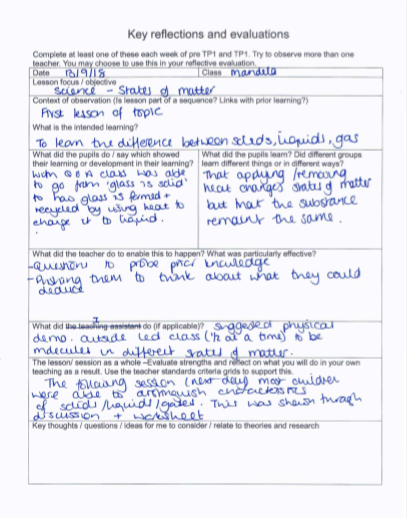
What can you tell me about solids/liquids/gas?
Can you give me an example of a solid? What makes it a solid?
Can you think of any way that you could change that solid into a liquid or a gas?
Does anyone have anything to add to what KO told us?
Why do you think that is?
Do you think that would work for all solids? Why?
Is there some way we could test this?
Can you think of any exceptions to this rule?
Appendix 2 – Lesson Plan showing attempt to use multiple choice hinge question
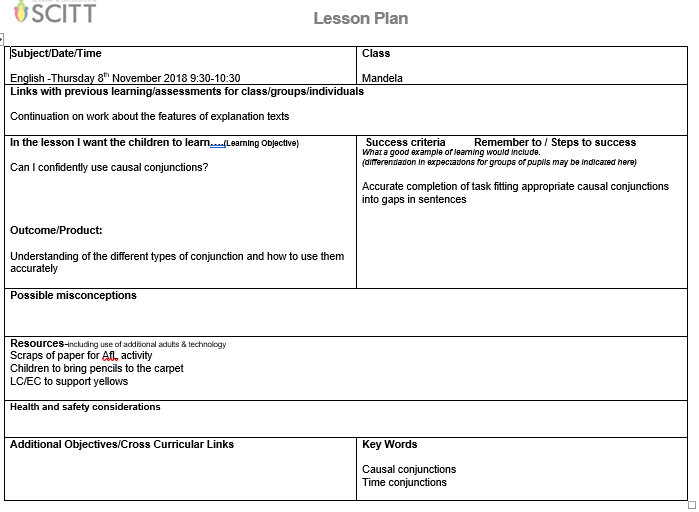
Questions went through what each one was, giving an example and using an example

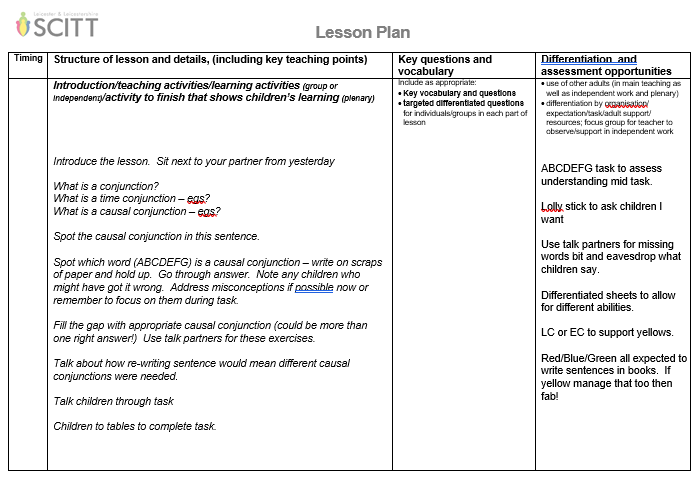
Children gave good answers – able to describe and give examples
Children found working with talk partners a problem. Not used to doing this. Some reluctant to talk; some relied on stronger partner to give answer
Children unfamiliar with having pencil & paper – struggled not to fiddle
Appendix 3 – Slide showing Hinge Question used in lesson
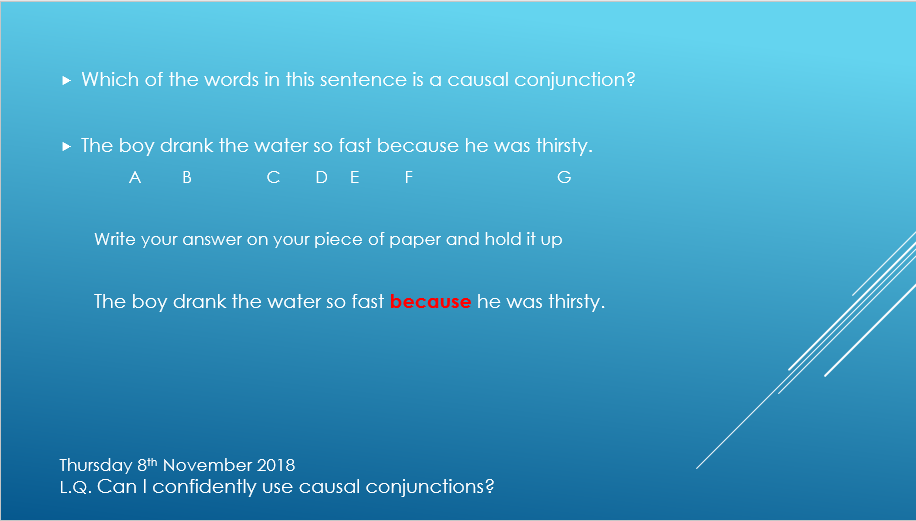
Displayed sentence as part of slide show. Read question aloud to the children. Clarified which letter referred to which word. Asked children to decide on the causal conjunction and write it on their whiteboard (used instead of paper). Once everyone was holding their choice for me to see, I asked a few children with different choices to explain their answer before I revealed it.
Appendix 4 – Lesson plans showing different style of hinge questioning
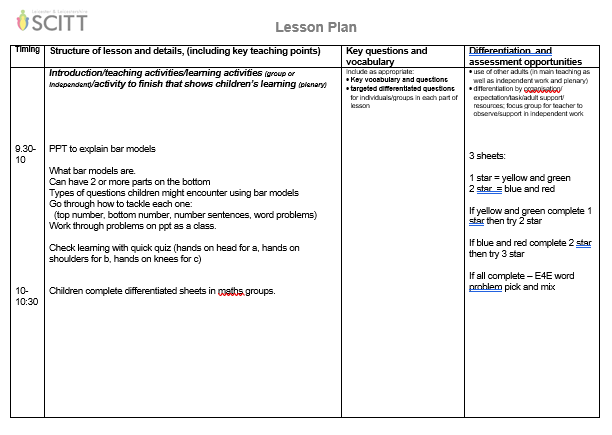
Hinge question to assess whether children are understanding lesson
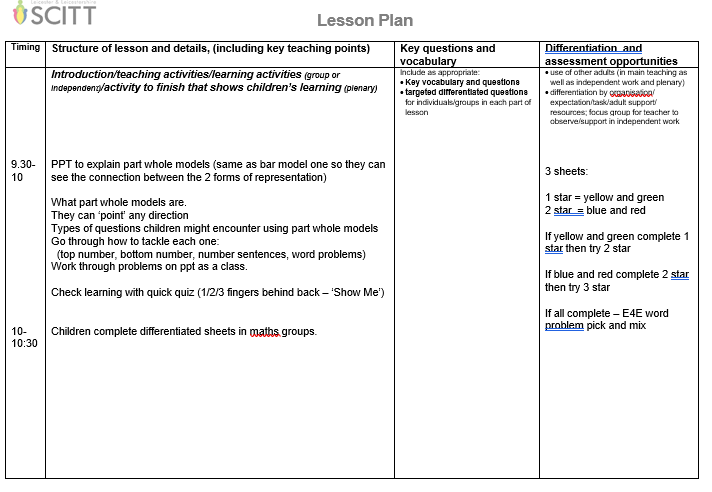
‘Show Me’ hinge question to check understanding
Appendix 5 – Copy of slide showing an example of a hinge question used
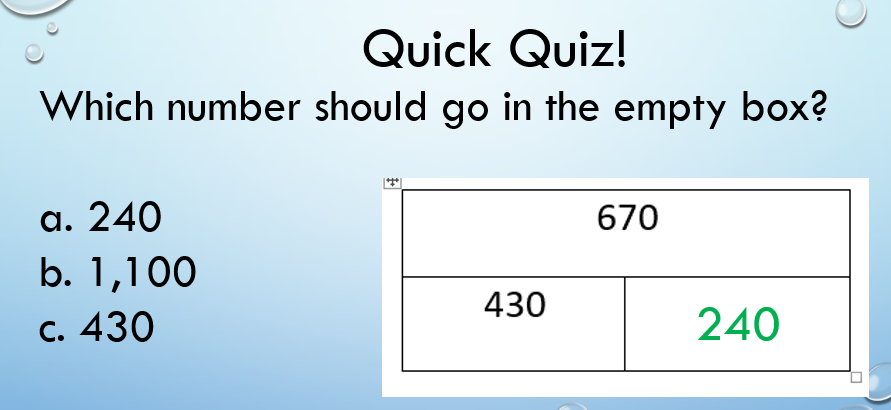
Hinge question used in lesson. Options chosen to help identify any misconceptions
Appendix 6 – Observation of lesson where children questioned teacher
|
Date 13th Oct |
Class Year 2 |
|
Lesson focus / objective Taking a different character’s viewpoint |
|
|
Context of observation (Is lesson part of a sequence? Links with prior learning?) Class have been reading George’s Marvellous Medicine by R. Dahl What is the intended learning? Children to write from the viewpoint of Grandma after she has been grown (before shrinking) |
|
|
What did the pupils do / say which showed their learning or development in their learning? Asked relevant and interesting questions |
What did the pupils learn? Did different groups learn different things or in different ways? To see things from a different point of view than the book is written |
|
What did the teacher do to enable this to happen? What was particularly effective? Teacher pretended to be Grandma and held a press-conference where the children had to ask her questions… “Why were you mean to George?” “What are you going to do now?” “What did the medicine taste like?” “Did you feel sick?” “What can you see from up there?” “Is it good being so big?” “How did it feel when you were growing?” “Will you punish George?” “Did it hurt when you broke through the roof?” “Are you cross with George?” “Do you want him to make you back to normal?” “Do you hate all children or just George?” etc.
After leaving the press conference, she ‘returned’ to being Mrs K – and asked the children about what they’d learnt from the questioning. |
|
|
What did the teaching assistant do (if applicable)? Passed the ‘mic’ from child to child |
|
|
Key thoughts / questions / ideas for me to consider / relate to theories and research Thought that this was a very memorable lesson and the use of questioning coming from the children not teacher was refreshing and interesting. Gave children good thoughts for going on to doing some writing about Grandma’s point of view. |
|
Appendix 7 – Bloom’s Taxonomy

Appendix 8 – Child’s work with success criteria grid
This child achieved all of the SC but not all of the them are visible from the worksheet. Some of them were through talk with their table and with me.
SC had been shared with the children on the board for the duration of the lesson
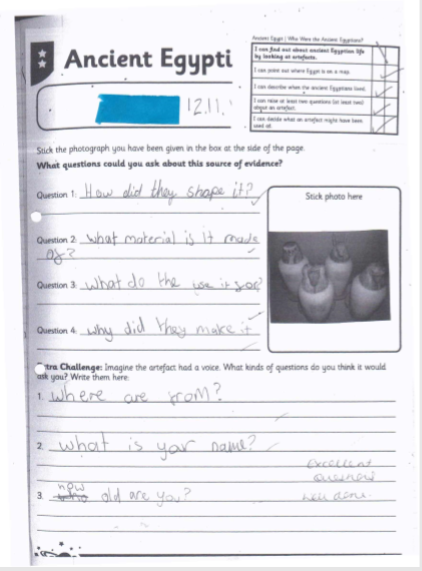
Appendix 9 – Verbal feedback recorded


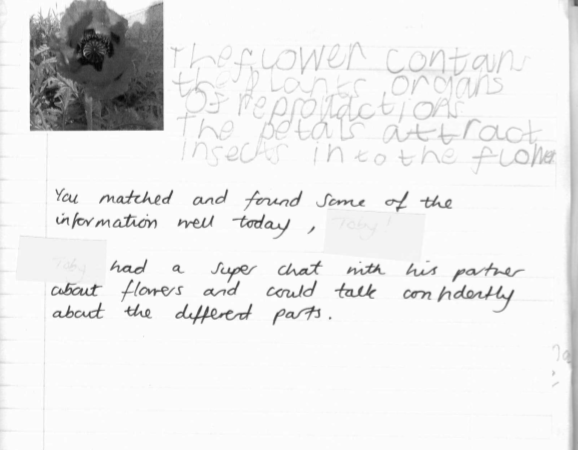
In this science lesson, the children had been observed having conversations about their work on flowers. As the learning objective was to identify the parts of a flower, this evidence of learning was recorded by the teacher in the form of a comment.
Appendix 10 – copy of non-negotiable grid used
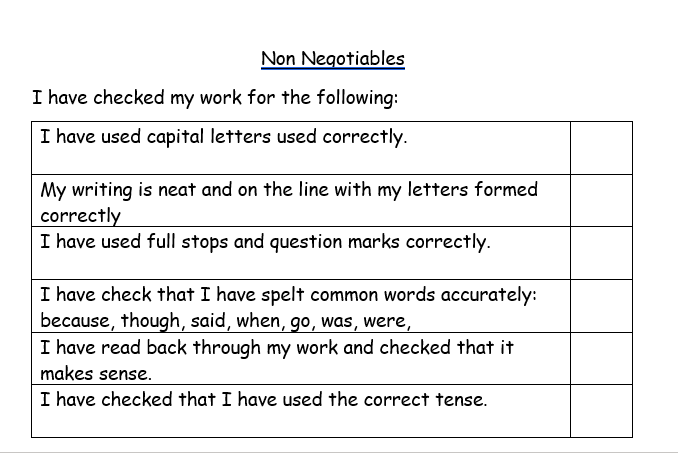
Appendix 11 – Feedback acted on
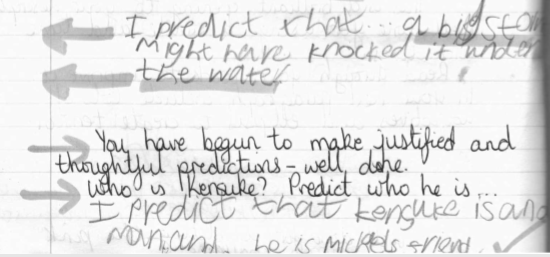
Here the teacher has encouraged the child to think more about the text that they are reading and make a prediction about the main character. The child has then had to think about this and write down his thoughts. She is leading him to make predictions about and has given him the opportunity to act on it.
Appendix 12
Lesson was planned after end of block assessment showed most children still had problems using the bar model accurately.

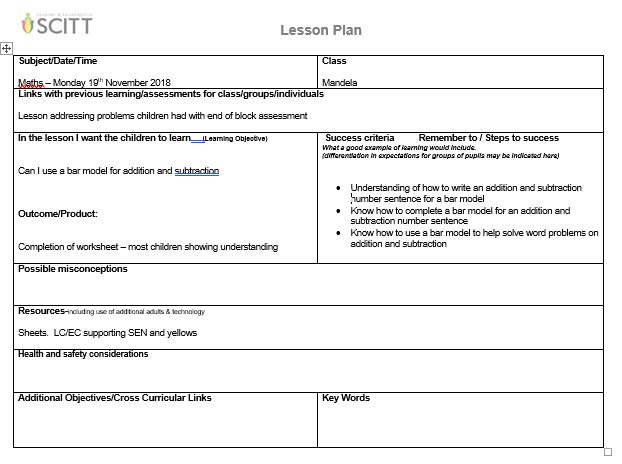
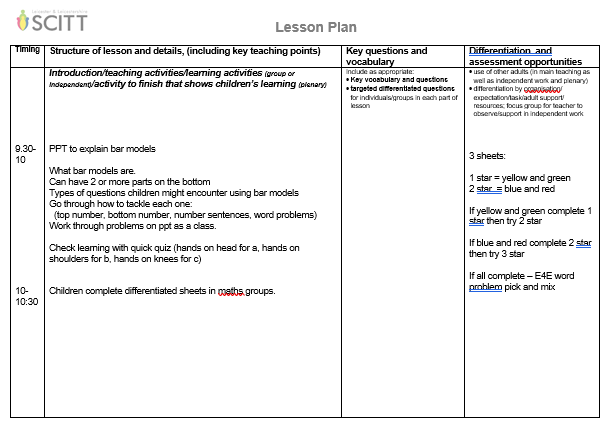
Hinge question to check learning.
This was one of three lessons planned specifically to address misconceptions that had been identified in the end of unit test.
Cite This Work
To export a reference to this article please select a referencing stye below:
Related Services
View allDMCA / Removal Request
If you are the original writer of this essay and no longer wish to have your work published on UKEssays.com then please click the following link to email our support team:
Request essay removal



